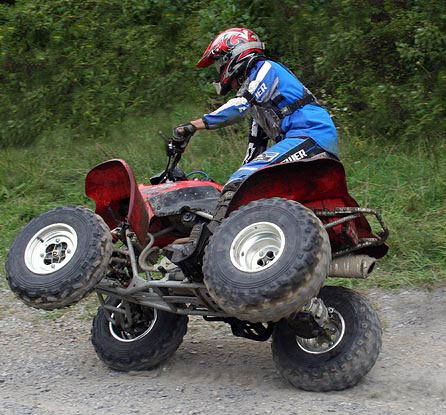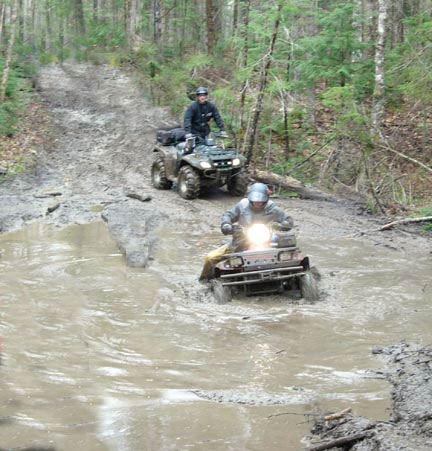ATV Riding Techniques
Good Habits from the Get-Go
by Jason Giacchino

With riding season approaching many of the country’s riders-in-hibernation will be reuniting with their well-rested ATVs. However with each riding season comes an influx of beginners getting their first taste of what off-roading is all about. While we all like to think we’re naturals at teaching others the nuances that separate a good day on the trails from a trip to the Emergency Room, the truth of the matter is operating an ATV is quite a responsibility and can be an intimidating process for a rookie.
The first step to consider when entering the ATV fray is taking an ATV safety course. It is truly invaluable in covering all of the bases from reading & respecting terrain to proper handling of your machine.
Purchasing a new ATV generally includes free access to such a course and we strongly advise making use of this benefit. We don’t lay claim to being capable in a single article to adequately replace the knowledge a rider gains by attending an ATV Safety Institute (ASI) ATV RiderCourse, we will offer some some tips and suggestions that make for good practice for riders of all skill level.
Get to Know Your ATV
Never assume all ATVs are the same. Each is a unique beast, from the way it sounds to its starting procedure. Read the owner’s manual and familiarize yourself with the layout of the controls well before setting the machine in motion.
Your owner’s manual should contain loads of useful information that can be applied to your pre-ride inspection. Tire pressure, control tolerances and tightening specs should all be covered, and these are items to take seriously before each and every ride.
Additionally never forget to take a look at your machine’s oil, fuel, and coolant levels prior to every ride. Yes, even when you convince yourself that it will be a “quick one”.
Most ATVs come equipped with a small tool kit and it’s not a bad idea to make sure you have yours in place should disaster strike in the middle of nowhere.
Designate an Area
This sounds like common sense, but when attempting to become familiar with the operation of a complex vehicle like an ATV, worrying about proximity to a cliff or pond, conquering rocks, roots or steep hills is completely unnecessary stress.
Rather, select a fairly wide-open space to get familiar with your machine’s handling. Ideally the area should have adequate space to perform maneuvers such as full turns and figure-8s. If possible, hard pack terrain with minimal elevation makes for ideal practice grounds. And while hard pack is recommended, avoid paved/concrete surfaces (obviously, and perhaps especially, this includes public roads) as low-pressure ATV tires aren’t intended to handle properly on such surfaces.

Gear Up
Statistics prove a sad reality: Most ATV injuries are head injuries. Suffice to say wearing a helmet may reduce the severity of these injuries. A helmet certified by the US Department of Transportation (DOT) and/or the Snell Memorial Foundation is the very least of what you should be wearing any time you are on your machine. In addition, we recommend over-the-ankle boots, goggles, gloves, long pants, and a long-sleeved shirt to protect against cuts, abrasions, and other injuries from rocks, trees, and other debris.
A plastic chest protector and a neck collar are also strongly recommended.
Posture
Head and eyes up, looking well ahead. Shoulders relaxed, elbows bent slightly out, away from your body. Knees slightly squeezing the gas tank. Feet on pegs/ footrests, toes pointing forward.
Starting, Stopping and Stuff
Perhaps getting the machine to move forward and come to a stop is a great place to begin. ATV transmissions are varied from fully manual (handlebar-mounted clutch) to fully automatic (just gas it and go). If in doubt, your machine’s manual will confirm your ATV’s configuration. Getting your machine to launch without spinning the wheels and then coming to a smooth, steady stop (without locking up the wheels) are essentials to master before considering riding the trails.
After mastering this straight-line technique, it’s time to move on to cornering. Unlike an automobile, most ATVs have a much narrower wheelbase and hence require body language to properly corner. The following techniques are critical to proper turning: Move your body weight forward and to the inside of the turn prior to entering the apex. Turn the handlebars while turning your head in the direction of the turn. Counterweight the machine’s natural tendency to tip outward while cornering by leaning to the inside. If the sensation of loss of control is eminent, gradually reducing the throttle and make the turn wider than anticipated.
Trail Bound
With successful mastery of start/stopping and confident cornering, you may be ready to transition to the trails. All of the basic principles apply here but new conditions enter the equation that demand specific skills. To touch upon some of these:
Hills:
To climb, shift the machine into a lower gear and try to build as much of your speed up before actually reaching the incline. The key to conquering ascents is momentum, not raw power. When approaching the uphill climb, move up on the seat and lean forward, or if the grade is particularly steep, stand and position your torso over the front wheels. Apply the throttle as required to maintain momentum until you crest the hill. To descend begin by selecting a path that is both as straight as possible with minimum obstacles/ obstructions. Shift your weight to the rear of the machine and use a low gear so that the engine can aid in keeping speed in check. On steeper downward slopes, straighten (but be certain never lock) your knees and elbows to allow your butt to exceed the machine’s seat. Get comfortable with using the rear brake to scrub speed and apply the fronts only when all else fails, smoothly so to prevent the front wheels from locking up.

Stream Crossings:
Maintaining control is critical when attempting to cross water- especially quick moving currents atop slippery moss covered rock beds. Always cross either at a 90-degree angle to the direction of the stream, or turn slightly upstream. Keep momentum up, especially if the depth of the stream proves deeper than anticipated.

Rocks, Logs, Stumps:
Beginner instinct is to jam on the brakes when the terrain gets ugly which can actually be more harmful than good. On the other hand holding the throttle wide open can un-weight the front end too severely to maintain control. The balance is to carry enough momentum to allow your front wheels to pass over an obstacle, realizing that the back wheels will inevitably follow. Be aware of your vehicle’s ground clearance and as always, stick to terrain within your capabilities.
Buffer Zone:
When traversing difficult terrain, make note not to follow the vehicle in front of you too closely. Not only are sudden stops commonplace in these conditions, but should the terrain become too difficult to continue, it is possible the leading vehicle may need to turn around. Sometimes the vehicle in front may even slide backward.
For additional tips and techniques, the ATV Safety Institute keeps an invaluable archive at the following address: http://www.atvsafety.org/InfoSheets/ATV_Riding_Tips.pdf
